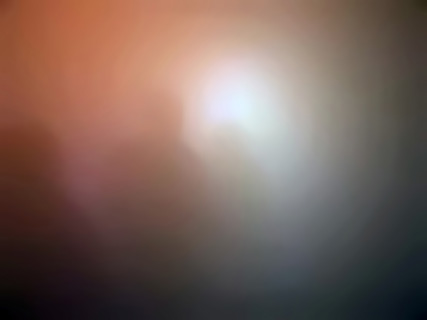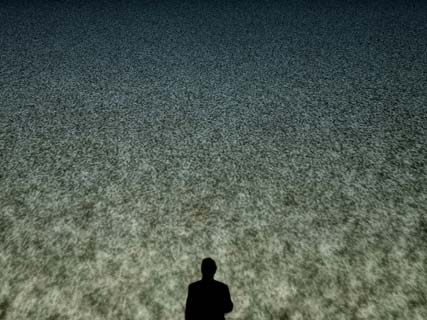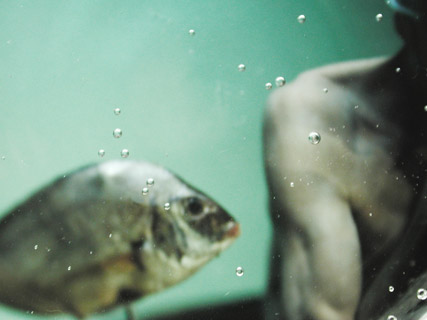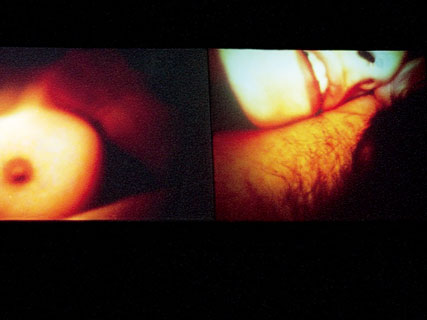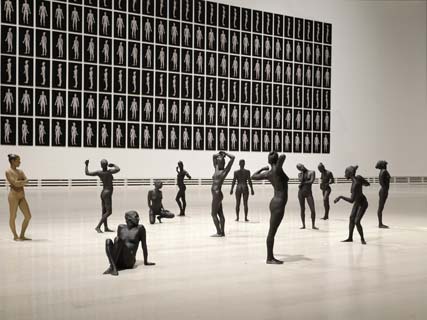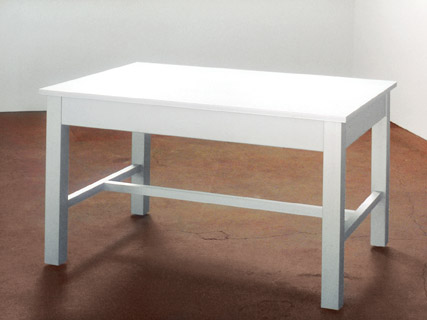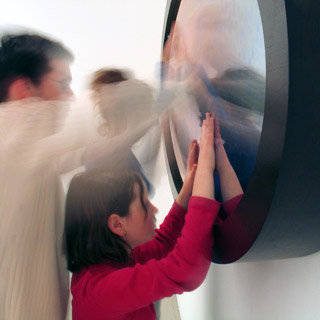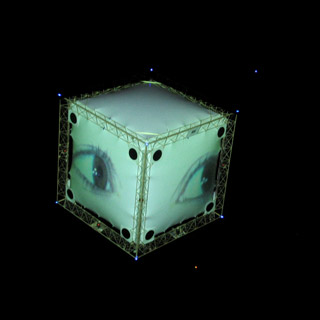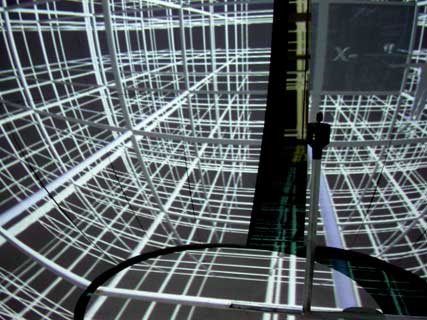Last May, the eighth chapter of the Elektra Festival was held at the Usine C in Montreal, which was this year enriched by an International Digital Art Market initiated by Alain Thibault, the Artistic Director of the festival. This first meeting, held during the day, made it possible to measure the interest that a broad range of researchers and other Montreal artists have for science and technology while the four evenings of the festival were focussed around a variety of audiovisual performances.
 T
The attraction science and technology holds for the artistic community of Montreal is not however something new as Expo 67, which was held in Montreal, already allowed a large public to discover the artistic potential of the communications technologies of the period with the very first multi screen devices, later referred to as multimedia environments. In 1995, the
International Symposium of Electronic Arts (ISEA) was also held in Montreal. But let’s come back to 2007, where the
Elektra Festival’s nights all ended with “Feed”, the immersive performance of
Kurt Hentschlager.
 Senses put to the test
Senses put to the test
 O
One must first of all agree to an obligatory “ritual” that involves signing a release stating that you are attending “Feed” at your own risk and that you do not suffer from any of the following illnesses: epilepsy, asthma, respiratory or cardiac problems, high blood pressure, migraines, eye or ear illnesses, claustrophobia or anxiety! It is only under these conditions that access to the room is granted. To begin with, a simplified human body appears that is neither masculine nor feminine, but just a puppet floating in space. A second then comes to join it and so on until the space of the projected image is entirely filled. They are all independent of each other, but all suffer the same spasms. A global recurring convulsion, accentuated by the music, unites them. Several images might come to mind with this heap of suffering bodies, but it is difficult not to think of mass graves. Artificial smoke then fills the space of the room, liberating us from these images that have become practically unbearable; a thick smoke that deprives us of all reference as the floor along with all the other spectators disappears. It is then our turn to escape gravity in this space that has been emptied by the smoke that fills it. The spectacle now plays out on our retinas where stroboscopic lights print hallucinogenic images that are impossible to escape because closing one’s eyes doesn’t change anything. The images cross the screens of our eyelids like rays of sunlight during a midsummer afternoon siesta. There are those who timidly try to get up, perhaps to give themselves the illusion of some kind of control over themselves, while others are accompanied to the exits. When everyone comes out, tongues loosen. Did you see what I saw? Did we see the same things, the same shapes, and the same colours?
Kurt Hentschlager,
“Feed”.
 T
The music of “Feed” evokes that of Ulf Langheinreich’s performance called “Drift” in the way it is endlessly drawn out. The two artists know each other well having founded the collective Granular Synthesis together in 1991 and the Elektra Festival has brought them together once again. There is something “aerial” in the sonic material of these two comparable performances that are occasionally like the sound of a plane. In fact, one of the many tableaux that “Drift” brings together appears to place the spectators in a low altitude flight when a cloud producing gaseous material unfurls before their eyes. The image and the sound participate together in a kind of infinite stretching of time and space. Ulf Langheinrich’s visual universe is extremely varied, but there are no real breaks during the performance. It is just a question of constant transformation of a matter that is at times organic and pictorial and at others regulated and linear. Fuzziness participates in this idea of continuous stretching just like the sweeping of black lines on a white background that transform into white lines on a black background without our ever really knowing when. Then there’s the moment when the graininess entering the image seems to disappear into its centre, without our ever truly knowing where. But it’s perhaps not very useful to ask so many questions about the images when the situation in fact incites one to contemplation…
Ulf Langheinrich,
“Drift”.
 From solitude to roaming
From solitude to roaming
 T
The Montreal artists Dominique
Skoltz and Herman
Kolgen easily adapted their performance to the Festival’s projection program on five screens as their project, called “Silent Room”, was conceived first as an installation in 2003, before becoming a film, a performance and then a book of photographs accompanied by a DVD Video and Music CD. “Silent Room” tells the story of people who are almost ordinary in a universe without epoch where the characters, like the décor, are subject to the wear of time. All of them are isolated or isolate themselves and spend their time killing time. Gustave is naked and only has goldfish for friends. Brehm is wearing a suit that goes perfectly well with his horse head and wanders alone in the corridors of what could very well be a station. Eleonor meticulously wraps the snout of a pig with string before ironing beef ribs with an iron. The insomniac man smokes cigarettes. He is in his underwear and won’t get dressed up anymore today or tomorrow than he did yesterday. His obsession is spying on what is going on in the room next door. Then there is Arto, room 381, the upper part of whose skull is covered with typographic characters and who is consequently obliged to hit his head against the wall to write what is on his mind, which is at the origin of his reclusion and his silence in his room.
Skoltz_Kolgen,
“Silent Room”.
 T
The performance “EEEoo8 [extended]” by the French collective
RYBN also comes from an installation where photography is central. Fragments of suburban landscapes become entangled with each other in an incessant flux of images. The elongated format of the projected image recalls the photography of 19th century panoramic architecture, but the city that is recomposed before our eyes only exists here and now. It is deserted and doesn’t seem to correspond with the beings that nevertheless still inhabit it, in contrast to the constantly recurring ideal city that was never inhabited. It only opens up when night falls and the sounds, like the colours are softened. There are occasionally disruptions in the image that hardly perturb it. The work of the RYBN collective belongs to a photographic tradition that consists of mapping cities and countryside to which a poetic dimension is added that expresses itself through the notion of wandering.
RYBN,
“EEEoo8 [ extended ]”.
 A crescendo aesthetic
A crescendo aesthetic
 I
It was during the third night of the festival at the Usine C that the French artist
Joachim Montessuis played “Eros: Agape”. Right from the start a sound loop emerges from the silence that accompanies us through till the end of the performance. It tirelessly repeats itself while becoming more complex, more filled in. The volume rises imperceptibly measure after measure and it soon hypnotises us while the five projectors project fragments of entwined bodies. The shots sometimes require a period of adaptation in order to recognise a hand, a mouth, and the nipple of a breast or a phallus. This amorous embrace inevitably ends in a burst of fractal shapes. At the same time, the sound loop that was there at the beginning becomes almost inaudible, drowned in a heap of layers that all participate in this rise in strength.
Joachim Montessuis,
“Eros:Agape”.
 T
Tt should be noted that Joachim Montessuis’ performance, like that of the members of the RYBN collective, received support from
ARCADI (Action Régionale pour la Création Artistique et la Diffusion en Île-de-France) via ACME (Aide à la Création Multimédia Expérimentale). As for the DVDs of “Drift” and “Silent Room”, they were co-produced by ARCADI whose multimedia department director, Gilles Alvarez, participated in the programming of Elektra by screening about thirty films taken from the international range of the last Némo Festival. Alain Thibault’s objective (artistic director of the Elektra Festival) in organising the first International Market around Digital Art is to encourage this type of exchange so that Canadian and European artists, spectators, producers and curators can meet. It is in this same framework that the Canadian artists nicholas feldman-kiss and
Max Dean present their creations while exhibiting at the same time at the
Projex-Mtl gallery.
 Between art and science
Between art and science
 n
nicholas feldman-kiss wants her name to be written in lower case letters. Is it to say that she is unique like the figurine that represents her, painted in flesh tones, while she is surrounded by black clones? The twelve figurines of the installation “A crowd of one self”, each about thirty centimetres tall were produced from a data base called “Mean Body” that gathers dimensions taken by a team of research scientists of the National Research Council of Canada, during a scanning session. The artist physically prepared herself for several months before by “sculpting” her body through sport so as to achieve a standard, because this is about sculpture. She was entirely naked, as all life models are, before entering the machine that enabled her to produce a few series of “mass produced” self-portraits. By representing the real as closely as possible to her features, nicholas feldman-kiss proceeds with a kind of “Ready Made” as the machines, in order to faithfully represent her in multiple postures, only base their work on her body, which is “already there”. The artist sculpting the artist’s body by herself takes on another dimension of performance that is anterior to the act of representation, which is delegated to the machines.
nichola feldman-kiss,
“i absolutely know i exist
(360 1 degree rotational views)”
and
“A crowd of one self”.
 M
Max Dean frequently collaborates with scientists also, as he did when he made “The Table: Childhood” with the engineer Raffaello d’Andrea. The table in question is equipped with electronic components that enable it to move, so it needs to be exposed in a room where the size of the entrances and exits prevent it from escaping. Its only form of expression is its movements made possible by castors on which it moves about. But be forewarned, it doesn’t communicate with everyone and it alone selects the “chosen”. It is of course the spectators who create the spectacle once the surprise effect has worn off: a table that moves! Each person then goes to great lengths to invent a new body language: a step to the left, then to the right, an abrupt gesture, a move forward then backward while those who have been rejected can only look on as spectators. A gesture in the play of actions is often repeated. It consists of warily touching the table with the tip of the finger or the palm in a caress that is similar to that given to an animal we believe we are taming. Unless of course it is only to verify through touch the existence of this “intelligent” table, which is also unique.
Max Dean,
“The Table: Childhood”.
 Researcher artists
Researcher artists
 T
The relation between artistic and scientific practices is particularly at the heart of what preoccupies the main Montreal universities, who on the initiative of Concordia University and the University of Quebec in Montreal (UQAM), share the
Hexagram laboratory. So the main actors of this institute of research and creation in media arts and technologies cumulate the status of both artist and researcher. A visit to Hexagram, which spreads over several spaces, makes it possible to discover “enhanced” objects with strange functionalities. A large mirror with an ovoid form that can be found in the premises of Hexagram Concordia, draws our attention. There is a piece of paper placed close to the mirror on which is written: “Do not clean”, and yet, judging by all the finger prints on its surface, this mirror is asking to be touched. It is in fact an interactive device called “Les Errances de l’Echo” created by the research artist
Jean Dubois, which is more sensitive to being caressed than being touched. And the most astonishing thing is that the mirror speaks to those who appeal to it, recalling the one that was located in a notable Queen’s bedchamber. Its comments range from advice to statements and are expressed around notions relative to the pose or the framing, to regrets or deceit. The tone is poetic, so the content is all the more philosophical.
Jean Dubois,
“Les errances de l’écho”.
 T
The UQAM Hexagram on the other side of the rue Sainte Catherine, is invaded with large sized cubes. The research artist Nicolas Reeves, the initiator of the SAILS (Self-Assembling Intelligent Lighter-than-Air Structures) project, calls them “
Mascarillon”. They are comprised of helium filled balloons with ultra-light frameworks within which small fans have been fixed that enable the Mascarillons to move about when floating in space. Their faces are able to receive projected images and it is through light and sound signals that they are likely to communicate with each other in order to gather together. Nicolas Reeves defines these robots as “social insects” and plans to study their behaviour by having them evolve within a spherical environment similar to that conceived by
Luc Courchesne.
 L
Luc Courchesne, who is still a research artist, is president of the
Society of Technological Arts (SAT) founded in 1996 by the organisers of ISEA 95. He still recalls the 360° projection of the Bell Pavilion at Expo 67, though he was only an adolescent. He has been questioning the notion of landscape within immersive devices such as the
360° Panoscope for several years. This device is made up of an over-turned half sphere whose interior surface serves as a screen to the light of a panoramic mono-channel projection. It thus offers several advantages, of which an economy of means compared to mechanisms requiring several projectors and is accessible to a group of visitors, as opposed to systems that induce the use of virtual reality headsets.
Luc Courchesne,
“Panoscope 360”.
 And more…
And more…
 L
Luc Courchesne is among the artists having received support from the
Daniel Langlois Foundation for Art, Science and Technology, which is celebrating its ten year anniversary with an exhibition entitled “e-art: new technologies and contemporary art” at the Musée des Beaux Arts de Montreal up until the beginning of next December. It would be an omission to not also point out the presence in Montreal of the
Oboro Centre for artists that has been focused on emerging practices since 1982. Then there are Canadian artists like
Steve Heimbecker and
Ken Gregory, who can be discovered or re-discovered during the International Digital Art Market. Lastly, there are other Montreal festivals like
Mutek,
Champ Libre,
Hhtmlles and the
Mois Multi, which is based in Quebec City. This will not be my last visit to Quebec…
Written by Dominique Moulon for "Images Magazine" and translated by Geoffrey Finch for "newmediaart.eu", this article is also available in French on "nouveauxmedias.net".
